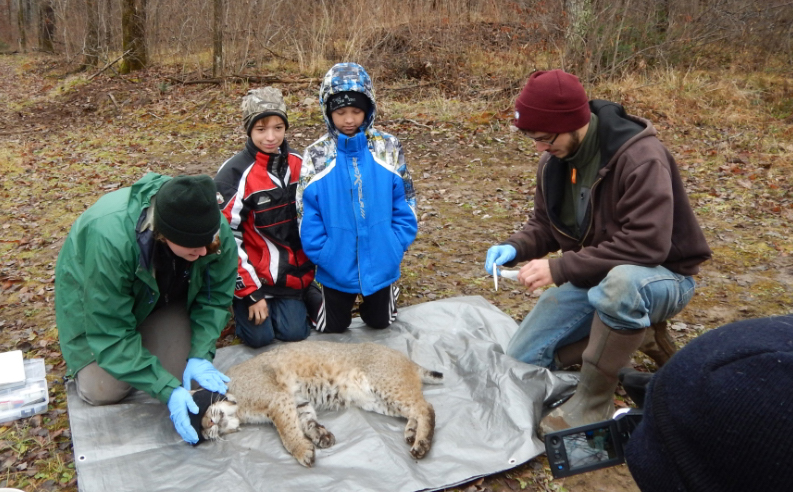Wisconsin DNR research project shedding light
on "cryptic" Bobcat
,

DNR wildlife biologists Teresa Pearson, left, and Nick Forman
examine the bobcat prior to fitting it with a GPS collar while
trapper Steve Maluegge's grandsons, Austin and Bray Schmidt,
look on.
While checking his coyote traps in the town of Pine River on Nov. 11, Merrill trapper Steve Maluegge discovered he’d caught a bobcat.
Steve has been trapping as a hobby for 15-20 years. He had legally harvested his first bobcat last year, but this year he didn’t have a permit for one, so this cat would have to be released
Not looking forward to that ordeal, Steve knew what to do. The Wisconsin Department of Natural Resources (DNR) had put out a call to trappers at the beginning of the season notifying them of a new bobcat monitoring project. The DNR asked trappers to contact them if they accidentally caught a bobcat. Steve called the number he’d been given and a team headed down from Rhinelander.
“They got down here from Rhinelander in about 45 minutes,” Steve said.
DNR wildlife biologists Nick Forman and Teresa Pearson sedated the animal, noted its weight, size and apparent age, and placed the collar on it. Steve was with his brother, Tom; son, Luke; and grandchildren, Bray and Austin Schmidt, that day. They were allowed to observe and participate in the process.
“I was fortunate to have my grandchildren with me that day,” Steve said. “The DNR researchers were just awesome to work with. It was really an educational afternoon.”
Steve’s leg hold trap hadn’t injured the 38-pound male. When the cat woke up, it was on its way and is now part of a bobcat research project intended to give the DNR a better understanding of the populations and habitat preferences of Wisconsin bobcat.
Steve said he’ll get a report from the DNR every three months to let him know the whereabouts of “his” bobcat.
Last year, the DNR conducted a pilot study in Vilas and Oneida counties. That study was expanded in 2015 to include 12 counties in the northeastern part of the state. For the 2015-2016 trapping season, research efforts include Ashland, Florence, Forest, Iron, Langlade, Lincoln, Oneida, Price, Rusk, Sawyer, Taylor and Vilas counties.
The DNR has so far collared and released 31 bobcats, 29 of which are still being monitored. Seven of those bobcats are in Lincoln County.
The purpose of the monitoring program is twofold, noted Nathan Roberts, large carnivore and furbearer research scientist for the DNR.
“We want to get an idea of what the harvest rates are,” he said, “and we use this information to get a better estimate of the population status.”
The DNR’s best estimate of the bobcat population in the northern zone is 2,500 animals. The harvest quota is directly related to the population estimate. Harvest data from Wisconsin’s 2014–15 bobcat seasons has shown that hunters and trappers harvested 274 bobcats. This marks the fourth year of expanded bobcat harvest and includes results from the newly opened southern bobcat harvest zone. In Wisconsin, hunters and trappers harvest about an equal number of bobcats.
Having a better idea of how many bobcats are out there will help the DNR set sustainable harvest quotas, Roberts explained.
-----------------------------------------------------------------------------------------------------
https://www.google.com/url?sa=t&rct=j&q=&esrc=s&source=web&cd=1&cad=rja&uact=8&ved=0ahUKEwjFt9vTqafRAhVrwVQKHSVfAUwQFggaMAA&url=http%3A%2F%2Fdnr.wi.gov%2Ftopic%2FWildlifeHabitat%2Fdocuments%2Freports%2Fbobcatharv.pdf&usg=AFQjCNFyXCwsza06Z8wM604_HMnr3MvYmg&sig2=EGJeJCWpfMfIami33oAIWw
Bobcat Harvest
2015 By Brian Dhuey and Shawn Rossler
Abstract
For a second year Wisconsin’s bobcat season had two zones each with two time periods for
pursuing bobcat by trappers and hunters. This was the second year that bobcats were legal for
harvest south of Highway 64. In each zone the first period ran from the 17th October through
the 25th of December with the second period from the 26th of December through the 31st of
January.
During the 2015 season 383 bobcats were registered or reported with the state,
including 277 taken with WDNR issued permits, 6 taken on reservations, and 50 taken off
reservation by native hunters/trappers, with 50 incidental kills submitted.
The non-treaty harvest included 198 bobcat that were trapped/hunted in the Northern Zone and 79 bobcat taken in the Southern. One hundred fifty-eight were shot over dogs, 77 were trapped, 5 by calling, and 37
taken with method of harvest unrecorded. The counties of highest harvest were Douglas (35),
Oneida (27), Price (19), and Sawyer and Burnett (18). The sex ratio from registration data was
0.93 male to 1.00 female
Thick forested areas of northern Wisconsin are home to the bobcat. They like alder thickets and coniferous swamps with black spruce, white cedar, or balsam firtrees especially.
In the southern part of the bobcat's range, they prefer upland areas when conifer swamps aren't found.
Male bobcats cruise a 25 square mile area and females only 15 miles in range. Fights can be prevented between bobcats since they mark their territory boundaries with feces, urine, and gland secretions. Young bobcats may wander as much as 100 miles across the land to find an unoccupied territory to make their home.
They have their fist litter of 2-3 kittens when they are 2 years old. Kittens are born between April and July in dens found in caves, rock crevices, or hollow logs or trees. The den is carefully lined with dry leaves, moss, or grass formed into a shallow depression. Kittens weigh 10-12 ounces at birth and are fully furred with their eyes closed at first. After 10 days the kittens can see and they will eat and gain up to .4 ounces per day. At 4 weeks old, they will leave the den and eat solid foods caught by their mother.
------------------------------------------------------------------------
https://www.google.com/url?sa=t&rct=j&q=&esrc=s&source=web&cd=6&cad=rja&uact=8&ved=0ahUKEwjWouzRq6fRAhWjwFQKHVicCGQQFgg2MAU&url=http%3A%2F%2Fwww.wpr.org%2Fbobcat-sightings-rise-southern-wisconsin&usg=AFQjCNGn19yvAbS0e4QFxsRgKpnlpA36Lw&sig2=gDtMIF56jD43shqTSYCyzQ&bvm=bv.142059868,d.cGw
Bobcat Sightings On The Rise In Southern Wisconsin
DNR Says It's Unsure What's Driving Trend
Thursday, March 10, 2016
By Rich Kremer













No comments:
Post a Comment